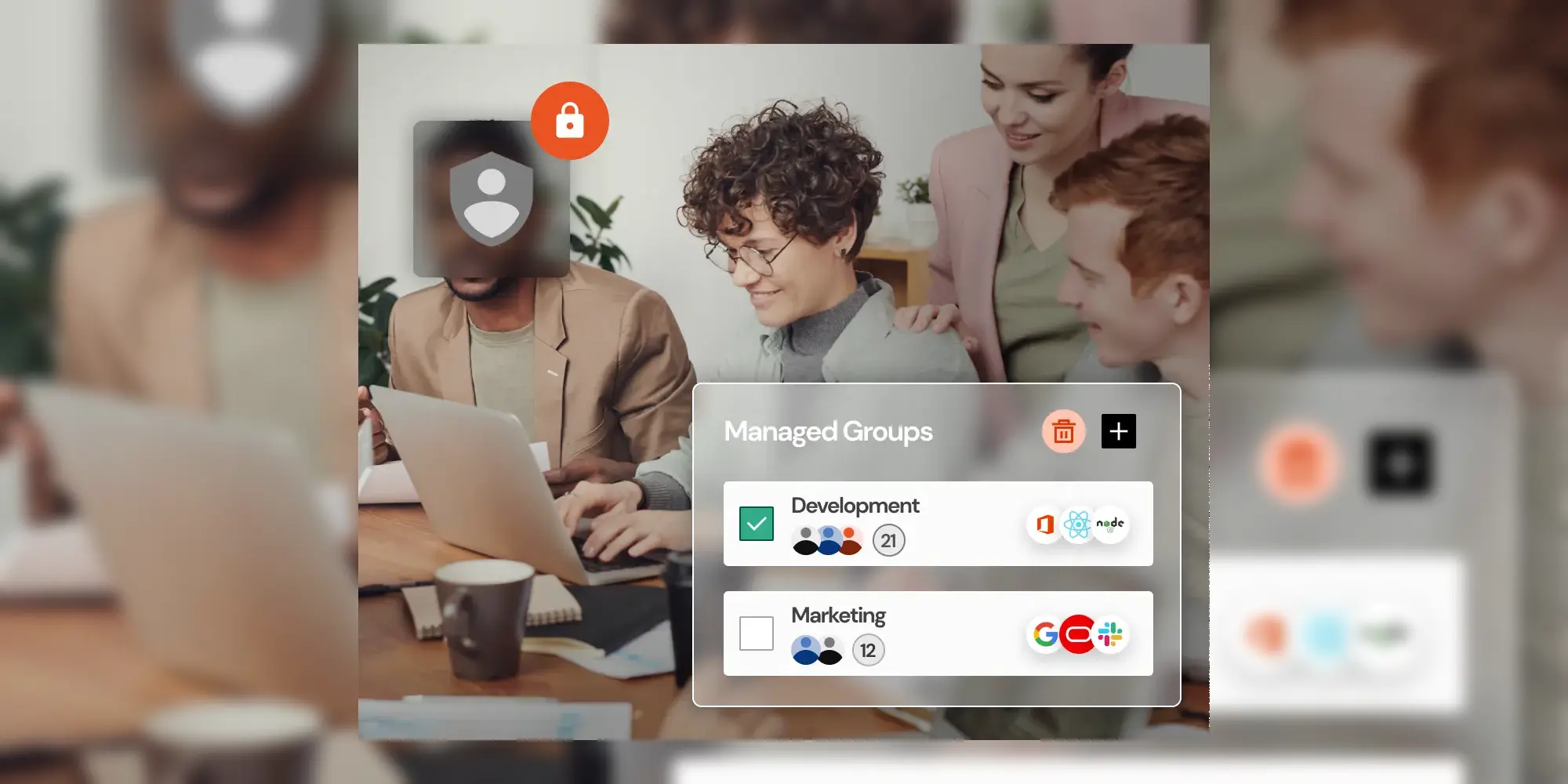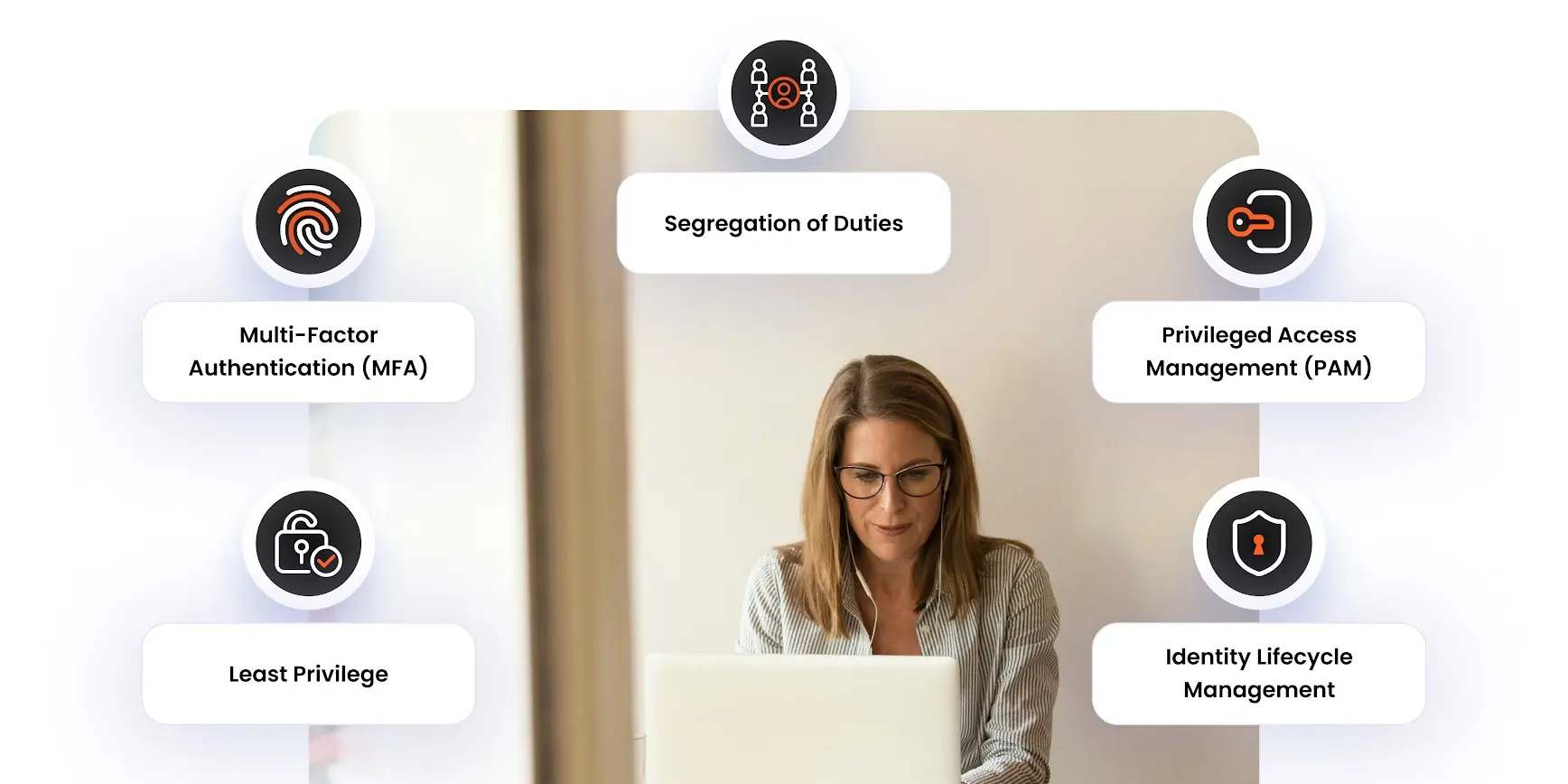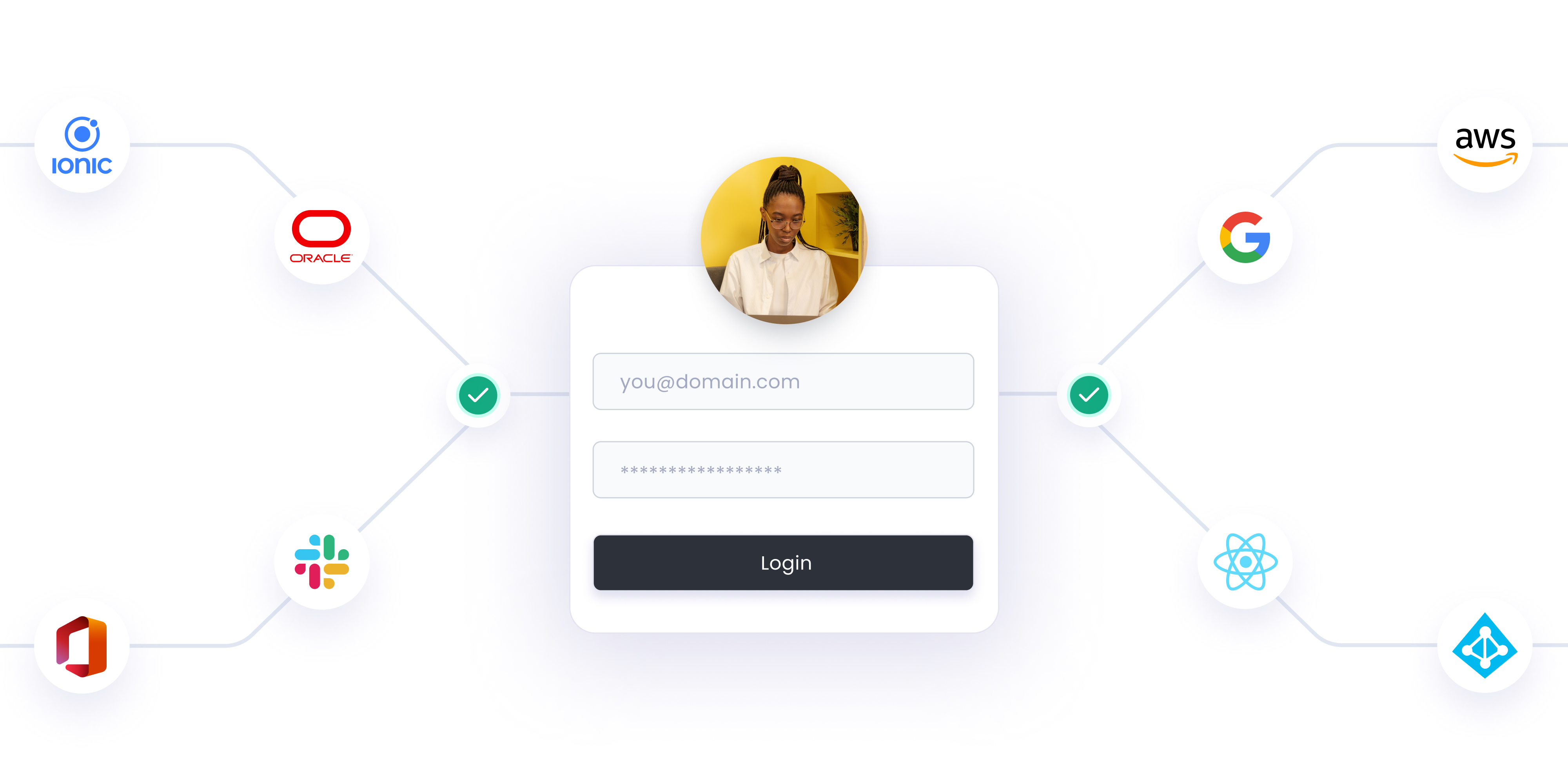Are your employees struggling with multiple passwords and access issues? Make their life easy with an enterprise-grade identity management solution. Manage digital identities at the enterprise level and ensure that the right people have the right access at the right time.
In this article, we will explore the fundamentals of enterprise identity management, its core components, benefits, challenges, and best practices. Also, we will see how organizations can meet compliance requirements and stay on top of trends in enterprise IAM. It covers how miniOrange enterprise identity management solutions benefit your enterprise with its rich feature set and integration capabilities.
What is Enterprise Identity Management (EIM)?
Enterprise Identity and Access Management (IAM) is a system that helps organizations manage who has access to their resources, like data, applications, and networks. It ensures that the right people have the right access at the right time.
Why Is It Important?
- Security: Protects sensitive information from unauthorized access.
- Compliance: Helps meet regulatory requirements and avoid fines.
- Efficiency: Simplifies user access management, reducing administrative workload.
- User Experience: Provides seamless access to resources, improving productivity.
In short, enterprise IAM helps safeguard data, ensure compliance, and enhance operational efficiency.
Common Identity Challenges in Organizations
These are common identity challenges that enterprise Identity and Access Management (IAM) solutions address:
- Identity Provisioning: Managing and granting user access to various systems and resources becomes complex as organizations grow.
- Regulations and Compliance: Organizations must comply with laws and regulations like GDPR and HIPAA, which require strict identity management.
- Data Security: Ensuring that only authorized individuals can access sensitive information to prevent data breaches.
- Nonhuman Identities: Managing access for devices, applications, and services, not just human users.
- BYOD (Bring Your Own Device): Securing access from personal devices used by employees.
- Threats and Attacks: Protecting against cyber threats and unauthorized access.
- Future Planning: Adapting to new technologies and evolving security needs.
Enterprise IAM helps organizations streamline these processes, enhance security, and ensure compliance with regulations.
Core Components of Enterprise IAM
The core components of Enterprise Identity and Access Management (IAM) include:
Managing User Accounts
- User Provisioning: Creating and managing user accounts efficiently.
- De-provisioning: Removing access when users leave the organization.
- Self-Service: Allowing users to manage their own passwords and profiles.
Controlling Access to Resources
- Access Policies: Defining who can access what resources.
- Role-Based Access Control (RBAC): Assigning permissions based on user roles.
- Multi-Factor Authentication (MFA): Adding an extra layer of security to verify user identities.
Simplifying Login Processes
- Single Sign-On (SSO): SSO Solution Allowing users to log in once and access multiple applications.
- Federated Identity: Enabling users to use their credentials across different organizations.
- Password Management: Implementing tools to help users manage and reset their passwords easily by using password management.
Benefits of EIM and Challenges in Enterprise IAM
Here are the benefits and challenges of Enterprise Identity Management (EIM) and Identity and Access Management (IAM):
- Improved Security: Protects sensitive data by ensuring only authorized users have access.
- Employee Productivity: Simplifies access to necessary resources, allowing employees to work efficiently.
- Cost Savings: Reduces costs associated with managing multiple identities and access points.
- Compliance: Helps meet regulatory requirements by maintaining proper access controls and audit trails.
Challenges in Enterprise IAM
- Legacy Systems: Integrating IAM with older systems can be complex and time-consuming.
- User Adoption: Ensuring all users understand and follow IAM practices can be challenging.
- Evolving Threats: Constantly changing security threats require continuous updates and monitoring.
Best Practices for Enterprise IAM Implementation
Best practices for implementing Identity and Access Management (IAM) in an enterprise include:
Planning Your Approach
- Assess Needs: Understand your organization’s specific needs and goals.
- Define Policies: Create clear policies for access and identity management.
- Choose the Right Tools: Select IAM tools that fit your requirements.
- Involve Stakeholders: Engage key stakeholders from different departments.
Giving Appropriate Access
- Principle of Least Privilege: Grant users the minimum access necessary to perform their tasks.
- Role-Based Access Control (RBAC): Assign access based on user roles within the organization.
- Multi-Factor Authentication (MFA): Use MFA to add an extra layer of security.
- Regular Reviews: Periodically review and update access permissions.
Monitoring and Adjusting
- Continuous Monitoring: Keep an eye on user activities and access patterns.
- Audit Logs: Maintain detailed logs of access and identity-related activities.
- Respond to Incidents: Have a plan in place to respond to security incidents.
- Adjust Policies: Regularly update policies and practices based on monitoring results and new threats.
Meeting Compliance with Enterprise IAM for Businesses
Key Regulations Affecting Enterprise Identity Management
Here are some key regulations affecting enterprise identity management:
- General Data Protection Regulation (GDPR)
- Sarbanes-Oxley Act (SOX)
- Health Insurance Portability and Accountability Act (HIPAA)
- Payment Card Industry Data Security Standard (PCI DSS)
- Gramm-Leach-Bliley Act (GLBA)
- Digital Personal Data Protection (DPDP) Act
- Family Educational Rights and Privacy Act (FERPA)
- North American Electric Reliability Corporation (NERC)
- National Institute of Standards and Technology (NIST)
How Does Enterprise IAM Support Compliance Efforts?
Enterprise Identity and Access Management (IAM) supports compliance efforts in several key ways:
- Access Control: IAM ensures that only authorized individuals have access to sensitive data and systems. This helps organizations comply with regulations that require strict access controls.
- Audit Trails: IAM systems provide detailed logs of who accessed what and when. These audit trails are crucial for demonstrating compliance during regulatory audits.
- Policy Enforcement: IAM enforces policies related to data protection and access rights. This ensures that the organization adheres to internal and external regulations.
- Identity Lifecycle Management: IAM manages the entire lifecycle of user identities, from onboarding to offboarding. This helps maintain accurate records and ensures that access rights are updated as roles change.
- Segregation of Duties: IAM helps implement segregation of duties by ensuring that no single individual has excessive access privileges. This reduces the risk of fraud and malicious activities.
By implementing these IAM practices, organizations can strengthen their security posture and ensure compliance with various regulatory requirements.
miniOrange Enterprise or Workforce IAM Solution
Features of miniOrange Enterprise or Workforce IAM Solution
- Single Sign-On (SSO): Access multiple applications with one set of login credentials.
- Multi-Factor Authentication (MFA): Adds an extra layer of security by requiring more than just a password.
- User Lifecycle Management: Automates user provisioning and deprovisioning.
- Passwordless Authentication: Eliminates the need for passwords.
- Adaptive Authentication: Adjusts security measures based on user behavior and risk.
- Directory Services: Supports integration with external directories like Active Directory (AD) and LDAP.
- Frictionless Secure Login: Simplifies access to applications for employees and partners.
- Remote Workforce Access: Securely access tools and devices from any location.
- Identity Brokering: Connects multiple apps with various external Identity Providers (IdPs).
- Two-Factor Authentication (2FA): Adds an extra layer of security.
- OAuth 2.0 Server: Securely authorizes access to resources.
Supported Integrations
- Pre-Integrated Apps: Over 6000 pre-built integrations for seamless SSO, MFA, and provisioning.
- APIs: Connects with various applications and services using APIs.
- Cloud and On-Premise: Flexible deployment options to suit different business needs.
- External IdP: Uses external Identity Providers for authentication and authorization.
- APIs and Directories: Integrates with existing directories and identity systems.
Futuristic Trends in Enterprise Identity Management
Some trends in Enterprise Identity Management that are shaping the future:
`1. Biometric Authentication
Using fingerprints, facial recognition, or even voice recognition to verify identity is becoming more common. It's secure and convenient.
`2. Multi-Factor Authentication (MFA)
This adds an extra layer of security by requiring two or more verification methods. For example, you might need to enter a password and then confirm your identity with a fingerprint.
`3. Decentralized Identity (DID) Solutions
Instead of storing identity information in one place, DID solutions distribute it across multiple locations. This makes it harder for hackers to access your information.
`4. Artificial Intelligence (AI)
AI is being used to detect unusual behavior and potential security threats. It can quickly analyze large amounts of data to identify risks.
`5. Zero Trust Security
This approach assumes that no one, whether inside or outside the organization, should be trusted by default. It requires continuous verification of identity and access rights.
`6. User-Centric Identity Management
This trend focuses on giving users more control over their own identity information. Users can decide what information to share and with whom.
These trends are making identity management more secure and user-friendly, helping organizations protect their data and comply with regulations.
FAQs
1. What is an enterprise identity management system?
Enterprise Identity Management (EIM) or Identity and Access Management (IAM) is the process organizations use to create, verify, store, and manage digital identities for their employees and sometimes customers.
2. What is the difference between IAM and IdAM?
Identity and Access Management (IAM or IdAM) is a system that identifies users and controls what they can do. Think of it like a nightclub bouncer who decides who can enter, who can't, and who gets VIP access. IAM is also known as Identity Management (IdM).
3. What is the IdAM tool?
Identity and access management (IAM) is a system of rules and tools that makes sure the right people in an organization have the correct access to technology resources.
4. What are the four components of IAM?
IAM components fall into four main categories: authentication, authorization, user management, and central user repository. Authentication is the process where a user provides credentials to access an application or resource.
5. What are the four pillars of IAM?
The four key components of identity and access management (IAM) are:
- Identity Governance and Administration (IGA),
- Access Management (AM),
- Privileged Access Management (PAM), and
- Active Directory Management (ADmgmt).
6. How does IdAM work?
Identity and Access Management (IAM) is the process of giving, tracking, and taking away access to data or systems for a specific user.
7. What are the 3 A’s of IAM? / 3 Basic A’s of Identity & Access Management
IAM (Identity and Access Management) procedures and technologies help manage authentication effectively. Authentication can be done alone or with authorization and accounting. A good password strategy is crucial for successful authentication.
8. What is the difference between IAM and UAM? / Streamlining User Access Management (UAM): IAM Basics
User Access Management (UAM) is a key part of Identity and Access Management (IAM) in modern IT systems. After verifying a user's identity, UAM ensures they get access to the necessary tools at the right time, based on predefined criteria for individuals or groups.
9. Why do companies need IAM?
Identity and Access Management (IAM) is crucial for protecting sensitive business data, defending against cyber threats, and meeting regulatory requirements. Implementing strong IAM solutions helps businesses manage access more efficiently, boost security, and enhance overall productivity.
Author





Leave a Comment